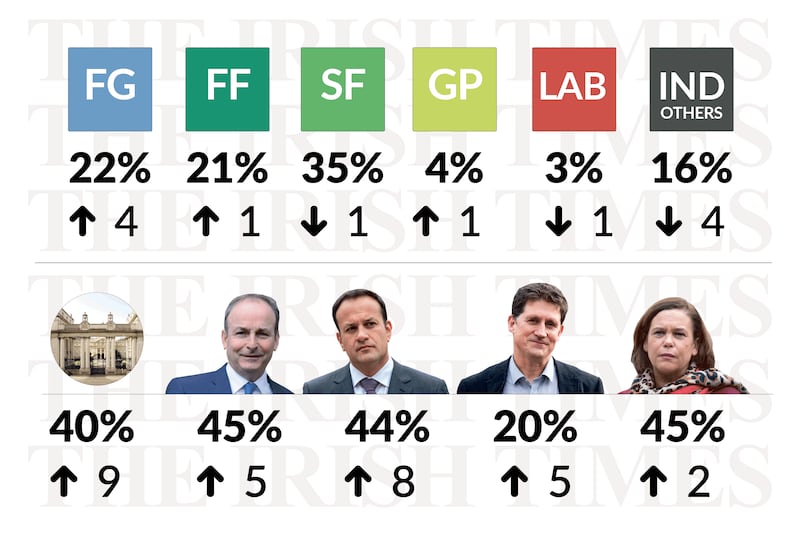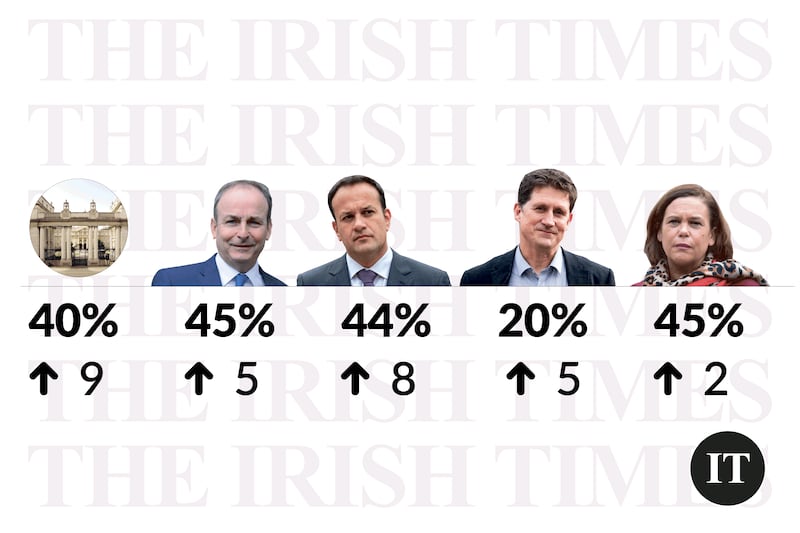Well, they’re not beaten yet.
Despite the continuing cost-of-living pressures, sky-high fuel prices and signs of a slowing economy, the Government parties have staged a perhaps unlikely comeback in the latest Irish Times/Ipsos opinion poll, adding six points to their aggregate support since July.
Moreover, satisfaction ratings for the three Coalition leaders and the administration as a whole have also jumped, while fewer people have a gloomy view of the general direction of the country. For a Government that is heading into a very difficult winter, it’s a significant boost – even if it’s a slightly unexpected one.
Who knows how long it will last? The Government faces several pressing difficulties, all of which are likely to get worse over the coming months.
READ MORE
At present it is scrambling to accommodate refugees from Ukraine while facing accusations of failing to plan and provide sufficient provision for them. And while nobody blames the Government for the influx of refugees from the war, Ministers are facing questions about why they are still talking about finding unused public buildings and providing modular housing several months after projecting that more than 100,000 refugees could arrive here. They are not questions to which they seem to have ready answers.

The cost-of-living crisis will continue, worsening over the winter months as the high cost of fuel bites. The economy is slowing and may enter recession, economists say, with difficulties caused by sky-high inflation continuing into next year. And in a month and a half the Coalition has to manage a transition of power between its two biggest personalities, a manoeuvre that has never been attempted before in these circumstances, with all the uncertainty and potential political turmoil that this entails.
But despite all that, the public mood towards the Coalition has clearly softened since the last poll in July, which showed falling support for the parties and plummeting satisfaction rates for their leaders.
And while it’s important not to overestimate the importance of any one set of numbers, it is true that polls play a not insignificant role in influencing morale – and that can have important political effects.
The net increase for the Coalition today is six points, with Fine Gael gaining the lion’s share of that with a four-point increase. The uplift in satisfaction ratings is also well beyond margin-of-error territory – Government up nine, Varadkar up eight and Martin up five. Even the Green Party’s Eamon Ryan, who has had his fair share of batterings in the polls, is up by five points to 20 per cent, running well ahead of his party.
[ Damian Loscher analysis: Budget gives Government parties opinion poll liftOpens in new window ]
So what’s behind this shift in the public mood since the summer? The data doesn’t provide clear cause-and-effect reasons. But there are indications that the budget package – which saw the Government announce billions of euro in supports to deal with the cost-of-living crisis – has begun to yield a political dividend. Further data to be published by The Irish Times over the coming days will bear out this analysis.
In addition, it can be assumed that the Coalition may have benefitted by comparison with its counterpart in the UK in recent weeks, where Irish voters will have seen a government tear itself apart through reckless decision-making and bitter internal rivalries. Voters may conclude that whatever their views of the Coalition here, it looks like fifth-century Athens compared to the Conservative Party.
It is Fine Gael that will probably be happiest with today’s numbers, rising by four points, with Varadkar’s personal rating up by eight. But this comes after a deeply worrying July poll that showed the party at its lowest rating since 1994.

Indeed, today’s poll perhaps represents a sort of a reversion to the mean, where taking the last number of polls together, the three big parties are settling around consistent brackets – Sinn Féin in the mid-30s, Fianna Fáil and Fine Gael in the low-20s.
You can look at this as the dominance of Sinn Féin over the old civil war parties, or you can take the view – as many Sinn Féin supporters do – that Fianna Fáil and Fine Gael are essentially the same political force; and if that is the case, their combined strength remains comfortably ahead of Sinn Féin.
Add the Greens, and the Government as a whole is doing pretty okay for a coalition in mid-term beset by all the usual difficulties and then some. That does not mean it is on course for re-election – we are a long way away from that yet – but it does mean that it has not crumbled. That is probably the message that the Coalition is best advised to take away from today’s numbers.
A word on the smaller parties. Three parties of the left trundle away at less than 5 per cent – Labour on 3 per cent (down one), the Social Democrats on 3 per cent (up one) and People Before Profit/Solidarity on 2 per cent (down one) – while Peadar Tóibín’s Aontú is on 1 per cent. As observed here many times, the smaller parties depend on a few strong candidates in a small number of constituencies. It helps if the party’s brand is strong, but it won’t get them elected on its own.
It is the Independents who cough up most of the support that flows to Fine Gael today – just as it was the Independents who benefitted when Fine Gael slumped in July. Nonetheless, support for the Independents, who include TDs of a great variety of political hues, is still as large as all the small Opposition parties – Labour, the Social Democrats, People Before Profit-Solidarity and Aontú – combined. They are perhaps the most unpredictable element on an unpredictable political landscape.













